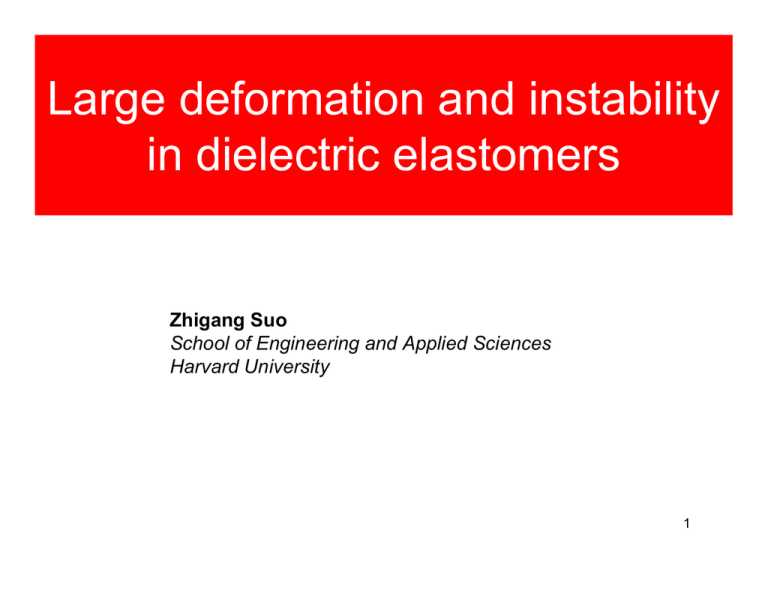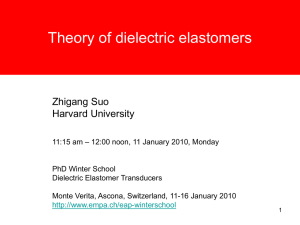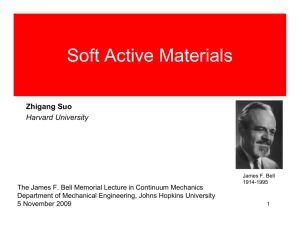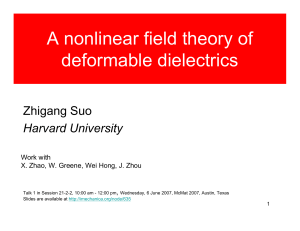Large deformation and instability in dielectric elastomers Zhigang Suo
advertisement

Large deformation and instability in dielectric elastomers Zhigang Suo School of Engineering and Applied Sciences Harvard University 1 Dielectric elastomer actuators Dielectric Elastomer A L a l Compliant Electrode Reference State Pelrine, Kornbluh, Pei, Joseph High-speed electrically actuated elastomers with strain greater than 100%. Science 287, 836 (2000). +Q Φ −Q Current State 2 Parallel-plate capacitor P battery a Φ −Q electrode l +Q Φ Q Φ = ε0 a l vacuum electrode Q P force Electric field Electric displacement field stress field E= Φ l Q D= a P σ= a D = ε0E ε0, permittivity of vacuum 1 2 σ = ε 0 E 2 Maxwell stress 3 Field equations in vacuum, Maxwell (1873) ∂Φ Ei = − ∂x i Electrostatic field ∂E i q = ∂x i ε 0 Fi = qE i A field of forces maintain equilibrium of a field of charges Fi = −Q ∂ ∂x j ε0 ⎛ ⎞ ε E E E E δ − ⎜ 0 j i k k ij ⎟ 2 ⎝ ⎠ P σ= E +Q ε0 2 E2 σ ij = ε 0 E j E i − Maxwell stress P ε0 2 E k E kδ ij 4 James Clerk Maxwell (1831-1879) “I have not been able to make the next step, namely, to account by mechanical considerations for these stresses in the dielectric. I therefore leave the theory at this point…” A Treatise on Electricity & Magnetism (1873), Article 111 5 Trouble with Maxwell stress in dielectrics -----------± +++++++++ Maxwell stress ε σ 33 = − E 2 2 -----------+ - +++++++++ Electrostriction Our complaints: •In general, ε varies with deformation. •In general, E2 dependence has no special significance. •Wrong sign? In solids, the Maxwell stress is a bad idea. 6 Trouble with electric force in dielectrics In a vacuum, external force is needed to maintain equilibrium of charges +Q +Q P Fi = qE i P In a solid dielectric, force between charges is NOT an operational concept +Q +Q Fi = qE i 7 The Feynman Lectures on Physics Volume II, p.10-8 (1964) “It is a difficult matter, generally speaking, to make a unique distinction between the electrical forces and mechanical forces due to solid material itself. Fortunately, no one ever really needs to know the answer to the question proposed. He may sometimes want to know how much strain there is going to be in a solid, and that can be worked out. But it is much more complicated than the simple result we got for liquids.” 8 All troubles are gone if we relate measurable quantities Reference State Current State A +Q a L l λ =l/L Φ s = P/ A ~ E =Φ/L ~ D =Q/ A −Q P Equilibrium condition Free-energy density Equations of state δF = Pδl + ΦδQ δF Pδl ΦδQ = + AL AL LA ( ) ~ ∂W λ , D s= ∂λ ~ ~ δW = sδλ + EδD ( ) ~ ~ ∂W λ , D E= ~ ∂D 9 Extend the theory to 3D inhomogeneous field Historical work •Toupin (1956) •Eringen (1963) •Tiersten (1971) …… Recent work •Dorfmann, Ogden (2005) •McMeeking, Landis (2005) …… Suo, Zhao, Greene, J. Mech. Phys. Solids 56, 467 (2008) 10 Two ways of doing work A field of weights do work through displacements: ∫ Biδxi dV + ∫ Tiδxi dA A field of batteries do work through changing: δQ ∫ ΦδqdV + ∫ ΦδωdA Φ P δl Equilibrium condition ∫ δWdV = ∫ Biδxi dV + ∫ Tiδxi dA + ∫ ΦδqdV + ∫ ΦδωdA 11 A field of markers: stretch L λ= l Reference state X l L Current state x(X, t) X+dX x(X+dX, t) FiK ∂x i (X ,t ) = ∂X K x i (X + dX ,t ) − x i (X ,t ) dX K 12 A field of batteries: electric field Reference state L Current state l X x(X, t) Φ ~ Φ E= L x(X+dX, t) X+dX Φ(X ,t ) Φ (X + dX ,t ) Φ (X + dX ,t ) − Φ (X ,t ) dX K ground ∂Φ (X ,t ) ~ = − EK ∂X K 13 A field of weights: stress Define the stress siK, such that ∫ siK ∂ξ i dV = ∫ Biξ i dV + ∫ Tiξ i dA ∂X K holds for any test function ξi (X) Apply divergence theorem, one obtains that ∂siK (X ,t ) + Bi (X ,t ) = 0 ∂X K in volume (s − iK (X ,t ) − siK+ (X ,t ))N K (X ,t ) = Ti (X ,t ) on interface 14 A field of charges: electric displacement Define the electric displacement D~K, such that + ∂ζ ~ −∫ DK dV = ∫ ζqdV + ∫ ζωdA ∂X K - + holds for any test function ζ(X). Apply divergence theorem, one obtains that ~ ∂DK (X ,t ) = q(X ,t ) ∂X K in volume ( ) ~+ ~− DK (X , t ) − DK (X , t ) N K (X ,t ) = ω (X , t ) on interface 15 Material model ( ) ~ W = W F, D ~ ~ δW = siK δFiK + E K δDK siK ~ ( ~ ∂W F, D ) (F, D) = ∂F , iK ( ) ~ ~ ~ ∂W F, D E K F, D = ~ ∂D K ( ) 16 A field theory A field of markers FiK (X , t ) = A field of weights ∂x i (X , t ) ∂X K ∂siK (X , t ) + Bi (X , t ) = 0 ∂X K A field of batteries A field of charges ~ ∂Φ (X , t ) E K (X , t ) = − ∂X K Equations of state ( ) ~ ~ ∂W F, D siK F, D = ∂FiK ( ) ~ ∂DK (X , t ) = q(X , t ) ∂X K ( ) ~ ~ ~ ∂W F, D E K F, D = ~ ∂D K ( ) 17 Construct a specific material model: ( ) ~ W F, D 18 The nominal vs. the true Reference State Current State A L +Q a l Φ ~ E =Φ/L ~ D =Q/ A (E = Φ / l) ( D = Q / a) −Q P Nominal electric field and nominal electric displacement are work-conjugate Battery does work ( )( ) ~ ~ ~ ~ ΦδQ = EL δ DA = ( AL )EδD True electric field and true electric displacement are NOT work-conjugate Battery does work ΦδQ = (El )δ (Da ) = (la )EδD + EDlδa 19 The nominal vs the true Reference State Current State A L Φ +Q a l −Q P s = P/ A σ = P/a ~ E =Φ/L E = Φ/l ~ D =Q/ A D =Q/a σ ij = F jK det(F ) siK ~ FiK E i = E K Di = FiK ~ DK det (F ) 20 Dielectric constant is insensitive to stretch Kofod, Sommer-Larsen, Kornbluh, Pelrine Journal of Intelligent Material Systems and Structures 14, 787-793 (2003). 21 Ideal dielectric elastomers Dielectric behavior of an elastomer is liquid-like, unaffected by deformation ( ) ~ D2 W F, D = Ws (F ) + 2ε Stretch Polarization Ideal electromechanical coupling is purely a geometric effect: Di = ( ) D i = εE i ( ) ~ ~ ∂W F, D siK F, D = ∂FiK ~ ~ ~ ∂W F, D E K F, D = ~ ∂D K ( ) FiK ~ DK det (F ) ( ) σ ij = FiK ∂Ws (F ) ⎛ 1 ⎞ + ε ⎜ E i E j − E k E kδ ij ⎟ det(F ) ∂F jK 2 ⎝ ⎠ 22 Zhao, Hong, Suo, Physical Review B 76, 134113 (2007) Neo-Hookean, incompressible dielectric elastomers ~2 D ~ µ 2 W λ1 , λ2 , D = λ1 + λ22 + λ23 − 3 + 2 2ελ21 λ22 ( λ3 L3 λ1 L1 λ2 L2 ) ( ) λ1 λ2 λ3 = 1 ~2 ∂W D s1 = = µ λ1 − λ1−3λ2−2 − λ1−3λ2−2 ∂λ1 ε ( Φ Q ) ~2 ∂W D = µ λ2 − λ2−3λ1−2 − λ2−3λ1−2 s2 = ∂λ2 ε ( ~ ~ ∂W D −2 −2 E = ~ = λ1 λ2 ∂D ε P1 P2 ) ( ) D = εE ( ) λ1 λ2 λ3 = 1 σ 1 = µ λ21 − λ23 − εE 2 σ 2 = µ λ22 − λ23 − εE 2 23 An application: Electromechanical instability 24 Electromechanical instability Φ +Q l 2 ~2 D λ ~ µ 2 W λ , D = λ + 2λ−2 − 3 + 2 2ε ( ) ( ) −Q l ( ) ( ) ~ ∂W λ , D s= =0 ∂λ Q ~ ~ ∂W λ , D E= ~ ∂D Φ ~ −1/ 3 ⎛ D2 ⎞ ⎟ λ = ⎜⎜1 + ⎟ ⎝ εµ ⎠ ~ ~ Dλ2 E= ε ~ ~ ~ −2 / 3 E D ⎛ D2 ⎞ ⎟ ⎜1 + = µ /ε εµ ⎜⎝ εµ ⎟⎠ Q ~ Ec ~ Stark & Garton, Nature 176, 1225 (1955) Zhao, Suo, APL 91, 061921 (2007) 106 N / m µ = 108V / m ~ −10 10 F / m ε λc ≈ 0.63 25 Pre-stretch increases actuation strain λ3 L3 λ1 L1 λ2 L2 Φ Q P2 P1 Experiment: Pelrine, Kornbluh, Pei, Joseph Science 287, 836 (2000). Theory: Zhao, Suo APL 91, 061921 (2007) 26 Coexistent states stiffening thinning polarizing +Q l Φ Φ −Q thick thin Q Top view Cross section Coexistent states: flat and wrinkled Experiment: Plante, Dubowsky, Int. J. Solids and Structures 43, 7727 (2006) Theory: Zhao, Hong, Suo Physical Review B 76, 134113 (2007) 27 Stiffening due to extension limit Non Gaussian statistics (e.g., Arruda-Boyce model): Ws = µ ⎡ 1 (I − 3) + 1 (I 2 − 9 ) + ...⎤⎥ ⎢2 20n ⎦ ⎣ I = λ12 + λ22 + λ32 µ: small-strain shear modulus n: number of monomers per chain Φ +Q l Φ −Q Zhao, Hong, Suo Physical Review B 76, 134113 (2007) Q 28 Finite element method Thick State Transition Thin State Thin State Transition Thick State 29 Zhou, Hong, Zhao, Zhang, Suo, Int. J. Solids and Structures 45, 3739 (2008) Summary • A field theory. No Maxwell stress. No electric body force. • Effect of electric field on deformation is a part of material model. • Ideal dielectric elastomers: Maxwell stress emerges. • Electromechanical instability. • Add other effects (solvent, ions, enzymes…) 30


